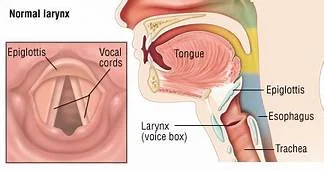What does singing LOOK like?
Normal Larynx from Harvard Health
“The larynx is a major (but not the only) source of sound in speech, generating sound through the rhythmic opening and closing of the vocal folds. To oscillate, the vocal folds are brought near enough together such that air pressure builds up beneath the larynx. The folds are pushed apart by this increased sub-glottal pressure, with the inferior part of each fold leading the superior part. Such a wave-like motion causes a transfer of energy from the airflow to the fold tissues. Under the correct conditions, the energy transferred to the tissues is large enough to overcome losses by dissipation and the oscillation pattern will sustain itself. In essence, sound is generated in the larynx by chopping up a steady flow of air into little puffs of sound waves.”
“In phonetics, vocal folds is preferred over vocal cords, on the grounds that it is more accurate and illustrative.”
These 1 - 2 cm delicate muscles make some big waves for how small they are!
Thanks Wikipedia 👍
You can also Check out this video about how the vocal folds work!
May 2, 2019
Everyone can benefit from voice lessons! Whether you’re a seasoned musician looking to challenge a plateau, or a fresh beginner wanting to try something new with your time, absolutely anyone can benefit from customized vocal sessions!
Do you have a deep connection with language and/or multiple languages? Do you find yourself training your ear to certain styles, rhythms, melodies, etc.? Do you suffer from vocal fatigue or exhaustion or need to figure out practical ways to create more stamina for your voice throughout the day? Voice lessons can help us to stretch the limits of our everyday form of communication by learning to manipulate the way in which air moves in and out of our bodies…the mechanics of singing.
Each person is different and unique, just like their voices they carry. So many facts and variables affect the voice; our bodies are so complex and sensitive, especially the delicate vocal folds. Those muscles are so small and tender, and yet respond to such nuance and subtlety. With individual, private vocal training, we can learn to capture the most beautiful and unique aspects of our voices and showcase them in the most splendid and confident ways.
Contact me today and see how you can learn to achieve a stronger, more confident voice!
Cheers,
Jenny
